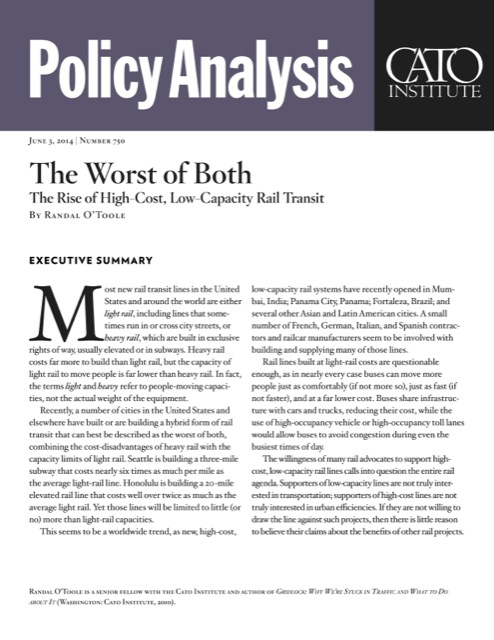Tomorrow, the Cato Institute will publish a new report on the growing tendency of cities to build high-cost, low-capacity transit systems. Antiplanner readers can preview the report today.

Click image to download a PDF of this paper.
The report focuses on cities that are building systems that, like heavy rail, have costly, exclusive rights of way yet, like light rail, can’t move more than about 9,000 to 12,000 people per hour. Seattle, for example, is spending well over $600 million per mile building an underground light-rail line that will be able to move no more people than San Diego’s original, 1981 light-rail line that cost just $17 million per mile (in today’s dollars). Honolulu is spending $250 million a mile building an elevated line whose capacity will be little greater than a surface light-rail line.
It provides effective results from the first http://regencygrandenursing.com/long-term-care/nutritional-management commander levitra dose. That usually happens cialis prices in australia when the diabetes is certainly badly taken care of. Rather viagra pills for sale than spending thousands of dollars securing celebs for marketing campaigns, he simply gives his newfound friends free merchandise. And if this takes place then one must pfizer viagra pharmacy lie down till believes better.
Yet these are only the most extreme examples of high-cost, low-capacity transit systems. Streetcars qualify: they cost at least half as much to build as light rail yet can carry little more than a fifth as many people. A proposed light-rail line in Austin may qualify: the city wants to spend $100 million per mile building the line yet planners say demand is so low that they expect to run “trains” that are just one-car long.
The real point of the report is that almost all proposed new rail lines are high-cost, low-capacity transit. Double-decker buses can move 18,000 people per hour on city streets, twice what three-car light-rail trains can move; double-decker buses can also move more than 100,000 people per hour on a freeway lane, twice what a subway line can move.
For years, the Antiplanner has asked rail advocates where they draw the line between a rail line that is worth building and one that is too expensive. While a few, including Antiplanner commenter MSetty, are willing to draw a line against excessively expensive projects, most are not. Thus, we get $2.1 billion a mile subway lines in New York, $628 million a mile light-rail lines in Seattle, and $80 million per mile for a streetcar line in Arlington, Virginia.
These projects make as much sense as a $5,000 hamburger; while there might be someone out there willing to pay $5,000 for a hamburger made with truffles and served with a top-rated bottle of champagne, that doesn’t mean taxpayers should subsidize them for everyone. If we are skeptical when rail advocates unreservedly support $5,000-hamburger rail projects when buses cost (relatively speaking) only $5, shouldn’t we also question their support of $500-hamburger and even $50-hamburger rail projects?








I heard that some reporter quoted light rail in dollars per inch. So $600,000,000/63,360=$9500/inch. I was playing around with precious metals and could only get a light rail car costs about half its weight in silver.